
On January 15, 2013, Facebook released Graph Search, which is the social network’s first attempt at a serious search engine. I’m glad Facebook launched Graph Search, since I often joked that the previous search functionality was so bad, you could barely find yourself.
I gained access to Graph Search on January 17, and have completed an enormous amount of research since then. In my first post on Graph Search, I explained its potential impact to privacy, reputation management, local search, and more. You should check out that post to gain a better understanding of how Graph Search works and the challenges that Facebook is dealing with.
While completing my research, it didn’t take long to dig deeper into local search, and to realize the potential impact to local businesses (if Graph Search truly takes off). Remember, Facebook now has 1.1 billion active monthly users and 665 million daily active users. It’s hard to ignore those numbers.
4 Focus Areas and Local Graph Search
Graph Search has only rolled out to a limited set of users at this point (less than 1 million), and will continue to gradually roll out to more users over time.
Graph Search currently handles four key areas: photos, people, places, and interests. And as you can guess, “places” should be of particular interest to anyone running a local business.
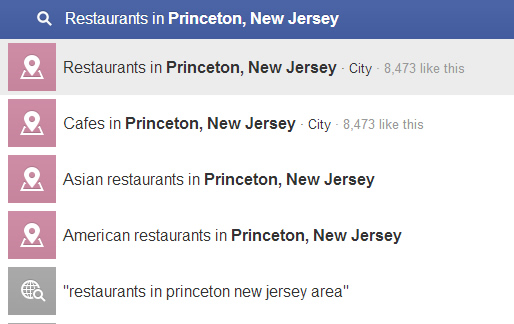
As Graph Search rolls out to more users, ranking well in place search could be an important driver of business for many local businesses.
SES New York and My Presentation on Graph Search
In March, I presented Facebook Graph Search at SES NY, focusing on local ranking factors for Facebook Graph Search, based on the research I have completed since mid-January. I also explained more about Nearby (now named Local Search on iOS), and how to boost rankings in Local Graph Search.
This post will cover a number of local ranking factors (and potential factors) for Graph Search. Just like Google’s algorithm, some of the factors carry a lot of weight, while others might contribute, but aren’t a driving force.
Again, this is based on my research and analysis, and Facebook will continually be refining its algorithm over time. And nobody knows the true Graph Search algorithm other than Facebook itself.
I’ll end this introduction with the standard disclaimer about ranking factors – correlation does not necessarily mean causation.
Without further ado, let’s jump into local ranking factors for Graph Search:
1. Social Connections

When performing local searches in Graph Search, Facebook surfaces places that my friends and connections have liked and visited. You can easily see this displayed in the SERPs when the listing includes “liked by {friend name here}”. Now, this is only one factor out of many, but it’s a strong one.
Takeaway: If you are a local business and don’t have a Facebook page set up, then set one up today. If Graph Search takes off, and you don’t have an official page, then you will be left in the dust. Think about it… if you don’t have a page, then nobody can like your official page. If users can’t like your page, then social connections of people searching Facebook cannot help lift your business in the Graph Search rankings. And I’ll cover the social engagement part of the equation later in the post.
2. Likes

After heavily testing Local Graph Search, it’s pretty clear that likes are a factor. You don’t need the most likes in your category, but you should always look to build more likes (the right way).
For example, since Facebook understands Page engagement, then zombie followers won’t help you. That’s unless you’re The Walking Dead.
Remember, Facebook wants to surface places that have a real following, places that users have voted for, etc. Having a solid like count (based on your category) absolutely seemed to impact rankings.
Takeaway: If you’ve had a Page for a few years, and still only have 14 likes, then you should start refining your social strategy today. You need a strong plan for publishing great content, promoting that content, and then engaging with your fans. And yes, Facebook Ads can absolutely help jumpstart your likes. I’m not referring to buying likes (which makes very little sense given my point about zombie followers from earlier). But a well-planned and researched ad campaign to gain likes from a specific niche is a great way to build real likes.
3. Check-ins

While testing Local Graph Search, check-ins clearly seemed to be a ranking factor. The more check-ins a place had built over time, the higher the correlation to stronger rankings.
If you’re a local business with a Facebook page, make sure you have selected “Local Business” as the category. You absolutely want people to be able to check in to your location.
It makes sense that check-ins are a factor, since Facebook will want to surface places that are actively seeing people visit the location. In addition, check-ins become exponentially more important when you take star ratings into account (covered soon).
Takeaway: Make sure users can check in to your location, and make sure your customers know how to do this. Everyone using Facebook’s mobile app has a mechanism for researching and checking into a place called Local Search (on iOS) and Nearby (on Android). I cover this later in the post, but it’s important that customers understand that Local Search is there and how to use it. Foster more check-ins. It’s clearly a ranking factor.
4. Proximity to Location in Query

Ah, a traditional local SEO ranking factor finally appears in the list! As you can guess, if someone searches for “restaurants in Princeton new jersey”, then it’s advantageous to be located in Princeton, New Jersey.
With Graph Search, I’ve unfortunately seen surrounding towns throw off the SERPs. So, make sure you have the correct address set up on your Page. Also include mentions of that city in your Page information (more on that in point 6).
Takeaway: Location is a strong signal, which shouldn’t be a shock considering we are talking about Local Graph Search. Make sure your address is accurate, mention your target locations in your Page copy, and hope Graph Search gets better at understand bordering towns.
5. Star Ratings
Say what you will about Facebook – I think it takes a smart approach to star ratings. And by the way, the ratings you see are not from Yelp. I know there’s a lot of confusion about where the actual star ratings come from, so it’s important to understand that they come from Facebook.
When a user checks in to a place via their Facebook app, Facebook obviously knows this. After checking in, Facebook might provide a ratings module to you later on (in the right sidebar while you are browsing Facebook). Users can also rate places they checked into by using Nearby in their Facebook mobile app (now called “Local Search” on iOS).
This approach to building star ratings is brilliant since it’s extremely hard to game. You can’t simply call up 500 friends and ask them to quickly give you a five star rating. They won’t have the ability to do that… since Facebook knows who checked in and is control of who sees the ratings module.
Start Ratings in Local Graph Search:

The Ratings Module in Facebook:

Image Credit: Inside Facebook
Takeaway: During my research, star ratings seemed to impact rankings in Graph Search. This is another reason it’s important to make sure customers know how to check in, and then how to rate your business (if they are prompted to after they leave). The more check-ins you can gain, the more star ratings you can get. The more star ratings you get, the more signals you can send to Facebook that your business should rank highly for targeted queries in Graph Search.
6. Facebook Page Optimization

In traditional SEO, there are certain elements under your control. You can control title tags, meta descriptions, content on the page, navigation, internal linking structure, etc. Well, for Graph Search, you can control the information that shows up in your “About” section.
Do not leave this content blank. It is absolutely used by Facebook to help its algorithm understand what your business is about. Don’t take it from me, Facebook even has a page set up explaining how to help users discover your business in Graph Search. And on that page, it clearly explains that you should flesh out the about section with important details about your business. When you add information to your page, you can include the following items:
- Category
- Subcategories
- Address/Location
- Short Description
- Description
- General Information
- Contact Information
- Food Styles
- Specialties
- Services
- Team
Takeaway: You control the data. Similar to traditional SEO, make sure you thoroughly complete the pertinent fields in your about page. Understand what users are searching for, and then make sure you provide high quality and useful information that matches what they are searching for. Sounds very traditional SEO-like, right? It is, and you can change this today.
7. Engagement
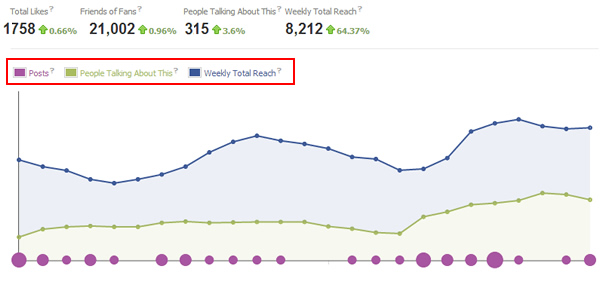
As I explained in my blog post about BeastRank (right before Graph Search went live), I fully believe that likes, shares, comments, etc. could impact Local Graph Search rankings. Facebook could very well be incorporating Page engagement into the Graph Search algorithm. It’s just another way for Facebook to ensure the businesses it returns in the search results are followed by real users, that those users are actively engaging the Page’s content, sharing its updates, etc.
Takeaway: Engage your fans, analyze your Page insights, and ensure you are providing high quality and relevant content. Take a hard look at the statistics that measure engagement like Engaged Users, Talking About This, and Virality. Look for ways to boost those metrics (the right ways).
8. Age on Facebook

This is total speculation, but it makes sense in certain situations. If there is a page that just pops up today, should it rank above a Facebook page that’s been active for three years, has been building likes consistently, and engaging its fan base? Probably not.
I don’t think this is purely an age factor, but just like domains and SEO, I believe Pages can benefit from age too. But again, you need to be doing the right things on Facebook… and not just letting a page sit there building dust.
Takeaway: If you’re a business owner that still hasn’t set up a Facebook page, then set one up today. If Graph Search gains in popularity as it rolls out to hundreds of millions of users, you could be left behind. Don’t let that happen. Build a strong social strategy now, and begin to engage users as soon as possible.
9. Photos In and Visitors In
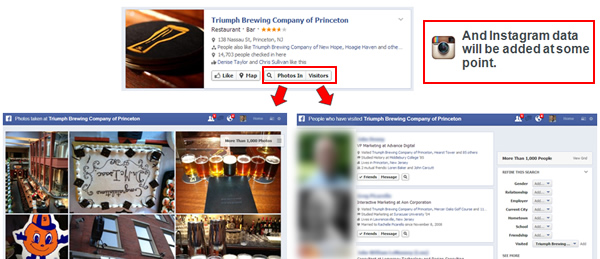
When you hover over a local search result in Graph Search, two buttons appear for “photos in” and “visitors of”. When clicking the “photos in” button, you are taken to a page that displays photos from Facebook users that have tagged a specific business.
When you click the “visitors of” button, you can see people that have visited that business. This is obviously more data for Graph Search to chew on, and can potentially influence the algorithm for local search.
For example, if Facebook identifies many photos tied to a business, that score could influence the search results. I’m not saying this factor is as strong as social connection or likes, but it could be a factor.
And by the way, Mark Zuckerberg already explained that Instagram data will be incorporated into Graph Search at some point. That’s a huge amount of photos and data and could absolutely impact Local Graph Search rankings.
For “visitors of”, I already explained how check-ins seem to be a strong factor, and this option lets you view actual Facebook users that have visited the location.
Takeaway: Encourage customers to take photos at your location. You can reinforce this with Page updates by highlighting new photos that your business was tagged in. The more signals you can send to Facebook about user activity, the better.
Now that I’ve covered a number of local ranking factors for Graph Search, I’m going to cover two additional important topics. First, I’ll explain more about Local Search (called Nearby on Android), which is sitting in your Facebook mobile app right now. Then I’ll cover Bing’s connection to Graph Search, including both organic and paid search.
Nearby (a.k.a., Local Search) and its Impact on Graph Search
During my SES NY presentation, I asked the audience if they were familiar with “Nearby” from Facebook. Only a few hands went up. That wasn’t shocking, since the functionality is somewhat hidden in Facebook’s mobile app and there hasn’t been a push to drive its usage.
Nearby (which is now named “Local Search” on iOS), is sitting in every Facebook app right now. Don’t believe me? Go check the menu in your Facebook app and you’ll see it sitting there. And for Local Graph Search, it’s ultra-important, since Nearby (a.k.a., “Local Search”) is essentially the mobile front-end to the Graph Search back-end.
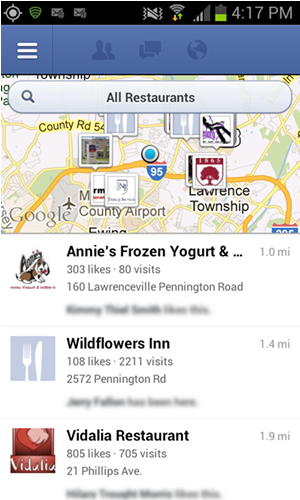
Using Nearby and Local Search functionality in your Facebook app, you can search for places of interest, based on your physical location.
When you click a specific listing, you can read more about the business, read recommendations from other users, view star ratings, etc. And yes, this is also how you can check in to a place and provide your own recommendations.
From a star ratings perspective, once you check into a place, you can rate that business directly from Nearby. And all of this data helps fuel Graph Search.
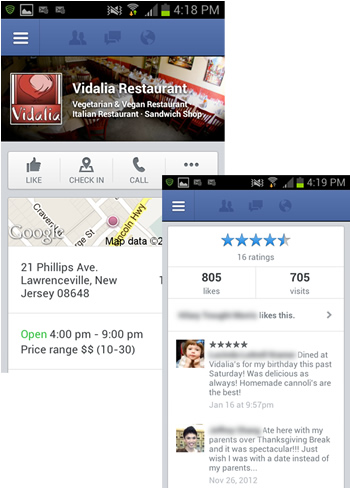
If you’re a local business owner, you absolutely should get familiar with Nearby and Local Search in the Facebook mobile app. And more importantly, you should make sure your customers know what it is and how to use it.
Let’s face it, if more of your customers know it’s there, more can check in, more can provide recommendations, and more can view the ratings module and provide star ratings.
The Graph Search Bing Connection
Facebook and Microsoft have a strong partnership. Microsoft was an early investor in Facebook and Bing has been working closely with Facebook on various social search projects. Well, Graph Search is one of the areas where the two companies have worked closely together. Below are some important points for you to understand about how Bing helps Graph Search, and how you can leverage that relationship to gain more customers.
- The Bing Fallback: Graph Search falls back to Bing results when it can’t answer your question. This happens when you enter traditional search queries (that don’t fit into the Graph Search taxonomy). Once you reach the Bing fallback results, you’ll notice that paid search ads are displayed. And yes, you can be listed there too! Facebook is a syndicated search partner, so selecting this option in Bing Ads will enable your ads to show up in the search results. It’s another great reason to launch campaigns in Bing Ads.

- Graph Search Passing Keyword Data: Based on that last bullet, some of you might be thinking more about the Bing fallback results and its impact on organic search traffic. A few days before my SES NY presentation, I was double checking how Facebook handled traffic it was sending to websites from the Bing fallback results. When Graph Search first launched, Facebook was not providing keyword data to destination websites (yes, a new type of “not provided” had hit the scene).
Well, during my research in late March, I noticed that Facebook reversed direction and started sending keyword data along with the referrer! To learn more about my findings, and how to track Graph Search keyword data in Google Analytics, you can read my blog post on the subject. I walk you step by step through setting up an advanced filter to capture the keyword data.

Next Steps for Local Business Owners
- If you haven’t already, request access to Facebook Graph Search. As of now, it has only been rolled out to a limited set of users.
- Double and triple check your Page information, categories, etc. Make sure you have “Local Business” selected as your category.
- Develop a strategy for gaining more likes (the right way). Avoid zombie followers.
- Boost engagement with your fans (with a strong content and social strategy).
- Encourage check-ins. They matter.
- Start using Nearby (now named “Local Search” in iOS), and educate customers about how to use it. Remember, it’s present in every Facebook app and can help your business build more power Graph Search-wise.
Local Graph Search – Start Now, Benefit Later
Hopefully this post helped you gain a solid understanding of the local ranking factors for Facebook Graph Search. Again, Facebook is still in the process of rolling out Graph Search to its 1 billion+ active user base, so now is the time to get your Page and social strategy in order. Review the factors listed above and determine how you can strengthen your local rankings in Graph Search.
Nobody knows how popular Graph Search will become, but it’s hard to ignore a social network the size of Facebook. In my opinion, there’s a narrow window of opportunity for local businesses to get their Graph Search situation in order. Jump through that window, and fast. Good luck!















